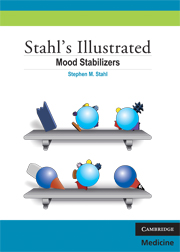Book contents
- Frontmatter
- Preface
- Contents
- CME Information
- Visual Vocabulary Legend
- Objectives
- Chapter 1 Symptoms and Spectrum of Bipolar Disorder
- Chapter 2 From Symptoms to Circuits
- Chapter 3 From Circuits to Mechanisms
- Chapter 4 Lithium and Various Anticonvulsants as Mood Stabilizers for Bipolar Disorder
- Chapter 5 Atypical Antipsychotics as Mood Stabilizers for Bipolar Disorder
- Chapter 6 Building a Treatment Plan
- Summary
- Addendum
- Abbreviations
- Suggested Readings
- Index
- CME: Posttest and Certificate
Chapter 3 - From Circuits to Mechanisms
Published online by Cambridge University Press: 22 October 2021
- Frontmatter
- Preface
- Contents
- CME Information
- Visual Vocabulary Legend
- Objectives
- Chapter 1 Symptoms and Spectrum of Bipolar Disorder
- Chapter 2 From Symptoms to Circuits
- Chapter 3 From Circuits to Mechanisms
- Chapter 4 Lithium and Various Anticonvulsants as Mood Stabilizers for Bipolar Disorder
- Chapter 5 Atypical Antipsychotics as Mood Stabilizers for Bipolar Disorder
- Chapter 6 Building a Treatment Plan
- Summary
- Addendum
- Abbreviations
- Suggested Readings
- Index
- CME: Posttest and Certificate
Summary
This chapter dives deeper into the neurobiology of bipolar disorder, introducing more specific mechanisms hypothetically involved in depression and mania. Particular ions, receptors, and channels that regulate neurotransmission within the circuits explained in Chapter 2 are hypothesized as sites of pharmacologic action for many of the drugs that are effective at relieving and possibly preventing symptoms of bipolar disorder. Chapter 2 often refers to “dysfunctional” circuits or “inefficient information processing;” this chapter explains the mechanisms by which such dysfunction can occur. To identify which pharmacologic actions may be beneficial in individual patients, it is necessary to (1) recognize the malfunctioning mechanisms that hypothetically correlate with each patient's symptoms and (2) understand the pharmacologic mechanisms of available drugs.
Chapter 3 begins to synthesize the information presented in Chapter 2, which provides a more general picture of symptom derivation, with more specific views of these mechanisms. Remaining mindful of these connections, the reader can look forward to integrating these with pharmacologic mechanisms in a more in-depth discussion of specific drugs presented in Chapters 4 and 5. The ultimate goal is to develop individualized treatment plans based on solid neurobiological and neuropharmacological awareness, and this is discussed in Chapter 6.
Ascending projections originate from locus coeruleus of brainstem to cerebellum, thalamus, Hy, BF, PFC, amygdala and hippocampus. Descending projections from spinal cord affect pain pathways.
Postsynaptic norepinephrine receptors have less distinguishable functions in the biology and pharmacology of mood disorders, although postsynaptic alpha 2A receptors may be specifically involved in cognitive functions in the prefrontal cortex.
The cortical brainstem glutamate projection (A), a descending pathway from prefrontal cortex to brainstem, regulates neurotransmitter release. The corticostriatal glutamate pathway (B) descends from the prefrontal cortex to the striatum and is part of the cortico-striatal-thalamic loops that are thought to control a variety of functions including emotion, attention, and executive function. Thalamocortical glutamate pathways (C) ascend from the thalamus, innervating pyramidal neurons in the cortex. Corticothalamic glutamate pathways (D) descend from the prefrontal cortex to the thalamus. Corticocortical glutamate pathways (E) contain intracortical pyramidal neurons that communicate with each other via glutamate neurotransmission.
- Type
- Chapter
- Information
- Stahl's Illustrated Mood Stabilizers , pp. 29 - 50Publisher: Cambridge University PressPrint publication year: 2009



